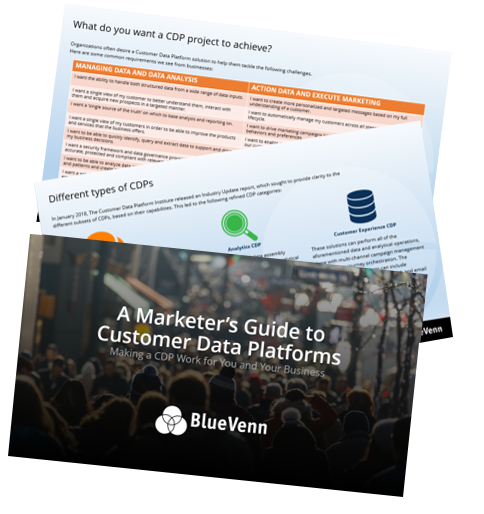Customer Data Platform series: 5 of 5
Over the next 5 weeks, read a new blog each week from our CDP Series as our CMO helps you to understand the CDP landscape, capabilities and functionality.
Let's just get something straight; it's common (and understandable) to assume that 'tag management' means organizing either the tags that make blogs more searchable or the meta tags used to improve the SEO of a web page. That isn't what we're talking about here.
This blog focuses on management of the snippets of code (tags) embedded into a web page to record information when a customer accesses and interacts with a company’s website or mobile app, or to help launch the functionality of marketing technology products. In the latter case, the vendor of the martech will request that the customer embeds the code. Just like a Customer Data Platform, the main function of a Tag Management System is to help manage large amounts of first-party information collected by companies about their customers.
So what is a Tag Management System?
 A Tag Management System assists with the implementation and management of ‘tags’ within a business’s websites and other digital properties. It does this through an interactive web interface that that allows you to easily implement, alter or maintain tags on your website or your other marketing platforms.
A Tag Management System assists with the implementation and management of ‘tags’ within a business’s websites and other digital properties. It does this through an interactive web interface that that allows you to easily implement, alter or maintain tags on your website or your other marketing platforms.
Just the one 'master' tag is needed to connect any piece of your martech stack to this central interface, which means no more data silos and no complicated coding. In other words, marketing teams can use the TMS with minimal support from IT.
The tags enable a company to perform customer tracking, analysis and reporting – which is useful when implementing agile marketing to boost conversion rates.
What does a Tag Management System do?
A TMS is used by businesses that want to establish a foundation for their digital data collection. It is primarily designed to help manage the lifecycle of these tags, replace the tags with single container tags and prioritize individual tags over others based on business rules, navigation events and known data.
Tag Management Systems are also used for increasing website speed, boosting workflow efficiency and providing behavior classification so that tools for analytics and personalization can be applied to enhance campaigns.
The Customer Data Platform Definition
 A CDP is packaged software, built for business users (mostly marketers), that will connect to all customer-related systems.
A CDP is packaged software, built for business users (mostly marketers), that will connect to all customer-related systems.
As with a TMS, marketers must know how to use a CDP, but don’t necessarily need to understand the intricacies of how it works under the bonnet. In short, the aim of the CDP is to empower the marketing team, and the business as a whole, to realize a coherent, trustworthy, and persistent ‘Golden Record’ from many data sources, without needing help from a team of engineers or IT.
The definition of a Customer Data Platform from the CDP Institute is "packaged software that creates a persistent, unified customer database that is accessible to other systems".
- "Packaged software": the CDP is a prebuilt system that is configured to meet the needs of each client. Some technical resources will be required to set up and maintain the CDP, but it does not require the level of technical skill of a typical data warehouse project. This reduces the time, cost, and risk and gives business users more control over the system, even though they may still need some technical assistance.
- "Creates a persistent, unified customer database": the CDP creates a comprehensive view of each customer by capturing data from multiple systems, linking information related to the same customer, and storing the information to track behavior over time. The CDP contains personal identifiers used to target marketing messages and track individual-level marketing results.
- "Accessible to other systems": data stored in the CDP can be used by other systems for analysis and to manage customer interactions.
How does Tag Management differ from a Customer Data Platform?
A TMS is not designed to gather, reconcile or clean customer data, therefore it does not automatically provide an insight to individual customers the way a CDP can. In other words, a TMS can't match your data to an identity, so there is no Single Customer View to help marketers personalize their content to each customer, nor will they be able to target customers with real-time campaigns. Plus, since tags must be embedded into a mobile or web-based platform, there is no way to monitor offline customer interactions, something a CDP is designed to do well.
However, marketers can feed a TMS into their CDP in order to enhance their view of the customer. Once paired with an identity, details of customer interactions are far more useful and can help marketers to understand those customers better, so target them more effectively with marketing campaigns.
This blog article is an extract from BlueVenn’s “A Marketer’s Guide to Customer Data Platforms” eBook.
Remember, this is blog 5 of 5 in our Customer Data Platform Series. For more from our CMO on the CDP landscape, capabilities and functionality, read the first blog in the series now or subscribe for alerts.
Want to know more? Download the ‘A Marketer’s Guide to Customer Data Platforms’ eBook

This blog article is an extract from BlueVenn’s ‘A Marketer’s Guide to Customer Data Platforms’ eBook.
Download a copy of the full eBook for more CDP advice, to discover how a CDP differs from other data management technologies, or to learn about the different types of CDPs and what to look out for when researching technology vendors.









